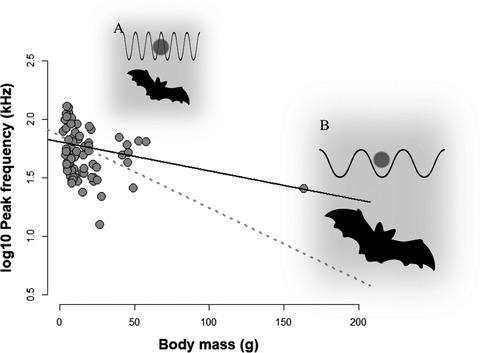当前位置:
X-MOL 学术
›
Mammal Rev.
›
论文详情
Our official English website, www.x-mol.net, welcomes your feedback! (Note: you will need to create a separate account there.)
Does body mass restrict call peak frequency in echolocating bats?
Mammal Review ( IF 4.9 ) Pub Date : 2020-06-19 , DOI: 10.1111/mam.12196 Issachar L. López‐Cuamatzi 1 , Víctor H. Vega‐Gutiérrez 2 , Iván Cabrera‐Campos 2 , Eduardo Ruiz‐Sanchez 3 , Jorge Ayala‐Berdon 4 , Romeo A. Saldaña‐Vázquez 5
中文翻译:

体重是否会限制回声蝙蝠的呼声峰值频率?
更新日期:2020-06-19
Mammal Review ( IF 4.9 ) Pub Date : 2020-06-19 , DOI: 10.1111/mam.12196 Issachar L. López‐Cuamatzi 1 , Víctor H. Vega‐Gutiérrez 2 , Iván Cabrera‐Campos 2 , Eduardo Ruiz‐Sanchez 3 , Jorge Ayala‐Berdon 4 , Romeo A. Saldaña‐Vázquez 5
Affiliation

|
- Echolocation is the ability of some animals to orient themselves through sound emission and interpretation of the echoes. This is bats’ main sense for orientation and recognising biotopes that provide food, water, and roosts. It is widely accepted that echolocation call frequency is related to body mass, and this relationship has been described as the ‘allometric hypothesis’, which proposes a negative correlation between these variables.
- There is evidence that, in many cases, the allometric hypothesis does not apply. Additionally, studies supporting this hypothesis were done at the family level, resulting in a broad range of correlation values with r ranging from −0.36 to −0.76, and only insectivorous bats were included. Due to the notable exceptions and the lack of a quantitative synthesis of this hypothesis including all echolocating bats, we evaluated the allometric hypothesis of echolocation calls for this group.
- Using a meta‐analysis and phylogenetic generalised least‐squares techniques, we evaluated the relationship between echolocation call peak frequency and the body mass of bats.
- We found a negative relationship between body mass and echolocation call peak frequency for the 85 bat species that were included in our analysis (r = −0.3, p = 0.005). The relationship was consistent when we analysed the data at the insectivorous guild level, and in bats belonging to the families Vespertilionidae, Rhinolophidae, Emballonuridae, and the genus Myotis. However, the wide range of r values suggests that the strength of the relationship between peak frequency and body mass varies within the order Chiroptera.
- Our results support the allometric hypothesis of sound production in echolocating bats. However, the low coefficient we found suggests that factors other than body mass may influence the peak frequency of echolocation calls produced by bats.
中文翻译:

体重是否会限制回声蝙蝠的呼声峰值频率?
- 回声定位是某些动物通过声音发射和回声解释来使其自身定向的能力。这是蝙蝠对方向和识别提供食物,水和栖息地的生物群落的主要感觉。回声定位调用频率与体重有关,这一关系已被广泛接受,这种关系已被描述为“异位假设”,它提出了这些变量之间的负相关性。
- 有证据表明,在许多情况下,异构假设不适用。此外,在家庭水平上进行了支持该假说的研究,得出了广泛的相关值,r在-0.36至-0.76范围内,仅包括食虫蝙蝠。由于显着的例外情况以及该假设(包括所有回声定位蝙蝠)的定量合成缺乏,我们评估了该组回声定位的异位假设。
- 使用荟萃分析和系统发育广义最小二乘技术,我们评估了回声定位呼叫峰值频率与蝙蝠体重之间的关系。
- 我们发现我们分析中包括的85种蝙蝠的体重与回声定位呼叫峰值频率之间呈负相关(r = -0.3,p = 0.005)。当我们在食虫行会级别以及属于Vespertilionidae,Rhinolophidae,Emballonuridae和Myotis属的蝙蝠中分析数据时,这种关系是一致的。但是,较大的r值范围表明,峰值频率与体重之间的关系强度在手翅目内变化。
- 我们的结果支持回声定位蝙蝠中声音产生的异构假设。但是,我们发现较低的系数表明除体重以外的其他因素可能会影响蝙蝠产生的回声定位声的峰值频率。


























 京公网安备 11010802027423号
京公网安备 11010802027423号